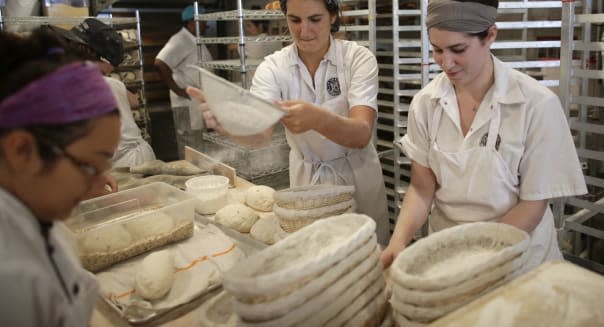Productivity Rebounds in 2Q, but Trend Still Soft

By Lucia Mutikani
WASHINGTON -- U.S. nonfarm productivity rebounded in the second quarter, but a weak underlying trend suggested inflation could pick up more quickly than economists have anticipated.
Productivity increased at a 1.3 percent annual rate in the April-June period, the Labor Department said Tuesday. But productivity, which measures hourly output per worker, rose only 0.3 percent from a year ago.
%VIRTUAL-pullquote-What it means is that inflation could be more problematic down the road, but we haven't seen it yet.%In line with annual revisions to gross domestic product published last week, first quarter productivity was revised to show it falling at a 1.1 percent rate instead of the previously reported 3.1 percent pace of decline.
"What it means is that inflation could be more problematic down the road, but we haven't seen it yet. It's something to think about long term," said Gennadiy Goldberg, an economist at TD Securities in New York.
Productivity is one of the metrics the Federal Reserve is watching as it contemplates raising interest rates for the first time in nearly a decade. Economists had forecast productivity rising at a 1.6 percent rate in the second quarter. The economy grew at a 2.3 percent annual pace in the period.
U.S. financial markets were little moved by the data, with investors focused on China's devaluation of its currency. U.S. Treasuries prices were trading higher, while U.S. stocks and the dollar fell.
Annual revisions showed productivity was unchanged in 2013, the weakest annual reading since 1982. Productivity in 2013 was previously reported to have increased at a 1.2 percent rate.
The average annual rate of productivity growth from 2007 to 2014 was revised down to 1.3 percent a year from 1.4 percent, well below the long-term rate of 2.2 percent a year from 1947 to 2014.
Output Gap Shrinking Faster?
Growth in productivity is an important determinant of the economy's non-inflationary speed limit. The downward revisions suggested the economy's growth potential could be lower than the 1.5 to 2 percent pace that economists have been estimating.
%VIRTUAL-WSSCourseInline-876%That would imply the spare capacity in the economy is being squeezed out more quickly than thought and that inflation pressures may take hold a bit faster than had been anticipated.
"We are growing much faster versus potential than we had previously thought. So the output gap over the more recent time frame looks like it is closing at a faster rate than we had thought prior to GDP benchmark revisions," said Jacob Oubina, senior U.S. economist at RBC Capital Markets in New York.
"The faster you close the output gap, the faster you get to that threshold where you start to see inflationary pressures."
But inflation remains benign for now. Unit labor costs, the price of labor per single unit of output, rose at only a 0.5 percent rate in the second quarter after advancing at a downwardly revised 2.3 percent pace in the first quarter.
They were previously reported to have increased at a 6.7 percent rate in the January-March period. Unit labor costs rose 2.1 percent compared to the second quarter of 2014.
Compensation an hour increased at a 1.8 percent rate in the second quarter after rising at a downwardly revised 1.1 percent pace in the first quarter.
Compensation was previously reported to have increased at a 3.3 percent rate in the first quarter. It was up 2.4 percent compared to the second quarter of 2014.
A separate report from the Commerce Department showed wholesale inventories increased 0.9 percent in June, higher than the 0.7 percent rise the government had forecast in the advance second-quarter GDP estimate.
June data on factory inventories and imports published last week suggested the GDP growth estimate could be revised to as high as a 3 percent rate.
